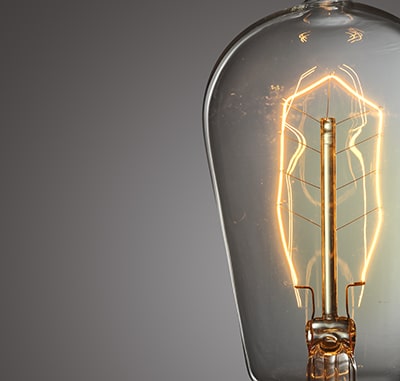AMPs, Watts, and Volts: A Guide to Measuring Power
Whether you’re making some home upgrades or wondering why your electricity bill is sky-high, it’s important to know how electrical power is measured. Different appliances may have different energy measurements listed, and understanding what they mean can be a challenge. At Brennan Electric, we want to help you out by offering this guide to measuring power, which includes common electrical units and tips on how electrical companies track your electricity usage.
Joule
A joule is a unit of energy. It was named after James Prescott Joule. One joule is equal to 1 kilogram multiplied by 1 meter squared multiplied by 1 second squared. It is used to describe the work done on one object when a force acts on it in the direction of motion it was already traveling in at the time. One joule is also used to measure electrical heat dissipation when 1 amp of current passes through an item with a resistance of 1 ohm for 1 second of time. The letter J is used to represent joules.
Ampere
The ampere, often shortened to “amp,” was named after André-Marie Ampère. He was a French mathematician and physicist who lived in the 1700s. He’s considered the father of electrodynamics. An ampere is a measure of 1 coulomb of electrical charge moving past a given place per second. The letter A is used to represent amperes. A coulomb is 1.602176634 x 10 – 19. This unit of measure was named after Charles-Augustin de Coulomb.
Volt
A volt is a unit of electrical power named after Alessandro Volta. He created the first electrical battery and discovered methane gas. One volt is defined as the difference in an item’s electric potential between two places on a conductive wire when an electrical current of 1 ampere of power releases 1 watt of power in the area between those places. The letter V is used to represent volts. Alternatively, volts can be expressed as joules per coulomb or kilograms multiplied by meters squared divided by amperes multiplied by seconds cubed. Battery power, electrical transmission lines, nerves and lightning are a few things measured in volts. A multimeter is a common household tool used to measure the electrical charge between two points.
Ohm
Ohm is a unit of electrical resistance. It is named after Georg Simon Ohm, who was a German physicist. One ohm is defined as the amount of electrical resistance between two places on a linear conductor when there is an ongoing potential difference of 1 volt between those points. The difference creates a current of 1 ampere in the conductor. Ohms are measures of power that you’ll see on speakers. The Greek letter omega is used to represent the ohm unit.
Watt
A watt is a unit of energy transfer. It is defined as 1 joule per second. It is named after James Watt, who was a Scottish entrepreneur. The letter W is used to represent watts. There are also many multiples of watts, such as kilowatts (1,000 watts) and terawatts (1 trillion watts). You’ll notice many common household items measured in watts. Some examples include light bulbs and microwave ovens. A lightning strike is 1 terawatt of power, but it lasts for just a few microseconds.
Decibel-Watt
A decibel-watt is used to measure electrical signal strength. It is the number of decibels to 1 watt of power. This unit is abbreviated dBW. You may find it used in microwave, radio or fiber optic items.
Ampere-Hour
The ampere-hour is a unit of electrical charge. It’s a measure of electrical current over a period of one hour. The abbreviation used is mA*H. This unit of electrical power is used for measuring some batteries, electroplating systems and X-rays.
Kilowatt-Hour
A kilowatt-hour is the amount of energy consumed in one hour. A kilowatt is 1,000 watts. Your electricity bill likely shows how many kilowatt-hours of power your home used during the billing cycle. Your electric meter shows kilowatt-hours of power you have used. A kilowatt-hour is abbreviated as kWh. Electricity companies usually set their rates per kilowatt-hour. A home may use 5 to 50 kWh of electricity per day, depending on the season, the size of the home and whether the home is all electric or if some of the appliances are powered by natural gas. For example, a heat pump is a big consumer of electricity while a gas furnace only uses a little electricity for its fan and sensors.
Tesla
You’ve probably heard of Tesla vehicles and Nikola Tesla, the scientist and inventor. Tesla is also a unit of magnetic induction. It’s not one that most people will encounter often. However, you might see it on loud speakers, magnets in your tools or on safety guides for computers, which can have their electronics damaged or destroyed by strong magnets. You may read about the strength of sun spots or solar flares with Tesla as the unit of measure. The abbreviation for a Tesla is T.
Hertz
Hertz is a unit of electrical frequency. This unit is named after Heinrich Rudolf Hertz, who proved that electromagnetic fields exist. Hertz is a common unit that you’ll see for describing musical tones, clock speeds, CPU speeds and radio waves.
Electrical Measurements and Use of Common Household Items
You’re probably familiar with the electrical measurements and use of many household items. For example, you likely use 9-volt batteries in your smoke detector. Your vehicle likely uses a 12-volt battery. USB cables use 5 volts of direct current power.
How Electrical Companies Measure Electricity Use
Electrical companies place a meter on the outside of residential and commercial buildings. These meters may be mechanical or digital. The digital meters automatically send usage information to the utility company. Some include an indoor unit that allows you to watch your energy usage. Smart meters may even come with an app that allows you to log into your account through your phone and monitor your home’s energy use. The smart meters send regular updates to the utility company so that they can increase or decrease capacity as needed.
Tips for Monitoring Your Electricity Use

At Brennan Electric, our electricians offer reliable electrical repair, maintenance, inspection, replacement and installation services. You can also turn to us for surge protection, generators, hard-wired carbon monoxide and smoke detectors and lighting installation. To learn more about how electrical power is measured or schedule any of our electrical services in Seattle or Lynnwood, call us at Brennan Electric today.

